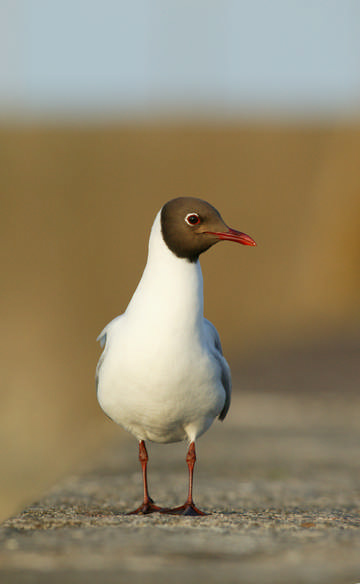
Black-headed Gull © Andy Harmer
There are three substantial Black-headed Gull colonies in the county. It can be difficult to count the numbers but estimates in 2004 were at least 1,000 pairs at Blakemere (SJ57K), 600-800 pairs at Woolston (SJ68N/ P) and 650 nests at Inner Marsh Farm (SJ37B); in 2005 the figures were at least 1,000 pairs at Blakemere and 500 pairs each at Woolston and Inner Marsh Farm. With fewer than ten nests at any other site, the county total lies in the range 2,000-2,500 pairs. This is the third highest total of inland-breeding Black-headed Gulls of any county in England, with the Cheshire population exceeding 10% of the English total, but unfortunately the county’s records were not submitted to the national ‘Seabird 2000’ survey (Mitchell et al 2004).
Our First Atlas noted the historical association of Black-headed Gulls with the Delamere area, going back at least 400 years, which had ceased by 1965. Gulls made sporadic attempts to nest in the area but the crucial event was the decision by the Forestry Commission to abandon tree production in the wettest part of Delamere Forest. In late 1996 the Forestry Commission cut down 46.7 ha of trees and allowed the area naturally to flood, re-creating Blakemere Moss. By 1999 Black-headed Gulls had colonised the lake, with their population rapidly rising and estimates of 200 pairs (2000), 400 pairs (2001), 450 pairs (2002), 800 pairs (2003) and 1,000 pairs (2004 to 2006).
Avoidance of ground predators, mainly foxes and rats, is crucial for breeding Black-headed Gulls, and overflying birds are always alert to the formation of a new island. Most nests are on the ground, amongst grass tussocks, or just above the water level in submerged bushes. Even there, they are not safe from minks, which cause havoc when they go through the colony at Woolston, or Lesser Black-backed Gulls, which in some years have taken a large toll of eggs and chicks at Inner Marsh Farm. No significant predation has been noted at Blakemere, although the site is not watched as regularly as the other two. Availability of food provides little constraint on the location of a colony as they obtain little food from the waters immediately surrounding it, and their diet is mostly terrestrial invertebrates obtained from farmland, especially earthworms and the larvae of tipulids and beetles.
Colonies are occupied from February, with the area filled with noise every second of daylight until the birds drift away in July. The cacophony of a Black-headed Gull colony means that no breeding concentration of any size should have been overlooked, but pairs can nest singly or in small groups anywhere and might have been missed. Most sites were recorded as large waterbodies, with odd birds in water-meadow and bog; off Parkgate they nested on the estuarine saltmarsh. One pair nested in 2004 at Frodsham in the top of a rotting wooden post in the Manchester Ship Canal, copying the Oystercatchers there.
The Black-headed Gull is on the UK’s Amber List of species of conservation concern because of its moderate population decline over the last quarter-century and its concentration into a relatively small number of sites, which makes it vulnerable to a localised catastrophe. On the other hand, the Cheshire and Wirral breeding population of Black-headed Gulls is probably higher than it has ever been, and a thorough count of all known colonies would be valuable.
Sponsored by Hazel J. Raw

